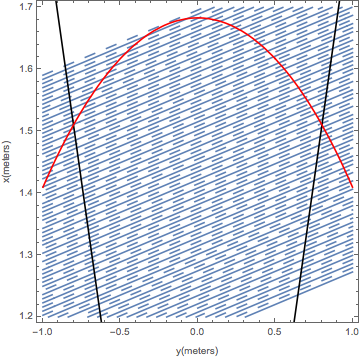Mathematica Simulation
Setting up Mathematica for DC Theta-Phi Isotropic Cone
We can define the constraints of the plane the DC is in
right = ContourPlot[
x2 == Cot[29.5 \[Degree]] y + .09156, {y, -1, 1}, {x2, 0, 1.8},
Frame -> {True, True, False, False},
PlotLabel -> "Right side limit of DC as a function of X and Y",
FrameLabel -> {"y (meters)", "x (meters)"}, ContourStyle -> Black,
PlotLegends -> Automatic];
left = ContourPlot[
x2 == -Cot[29.5 \[Degree]] y + .09156, {y, -1, 1}, {x2, 0, 1.8},
Frame -> {True, True, False, False},
PlotLabel -> "Right side limit of DC as a function of X and Y",
FrameLabel -> {"y (meters)", "x (meters)"}, ContourStyle -> Black,
PlotLegends -> Automatic];
We can define the x coordinate of the wires as they cross the midpoint plane as shown earlier.
x0forWires[number_] := .23168 + .01337*(number);
We can define the point midway between two parallel lines as the point where one wire is recorded versus its next highest neighbor
x0forWireMiddles[ number_] := ((.23168 + .01337*(number)) + (.23168 + .01337*(number \ + 1)))/2;
All of the conditions dependent on and
\[CapitalDelta]a :=
FullSimplify[(R Sin[\[Theta] \[Degree]])/
2 (Csc[65 \[Degree] - \[Theta] \[Degree]] -
Csc[115 \[Degree] - \[Theta] \[Degree]]), \[Theta] > 0];
e := Sin[25 \[Degree]]/Cos[\[Theta] \[Degree]];
a := FullSimplify[(R Sin[\[Theta] \[Degree]])/
2 (Csc[65 \[Degree] - \[Theta] \[Degree]] +
Csc[115 \[Degree] - \[Theta] \[Degree]]), \[Theta] > 0];
rD1 := Simplify[(a e - \[CapitalDelta]a) Tan[
65 \[Degree]] Cos[\[Theta] \[Degree]], \[Theta] > 0];
rD2 := Simplify[(a e + \[CapitalDelta]a) Tan[
65 \[Degree]] Cos[\[Theta] \[Degree]], \[Theta] > 0];
xD1 := Simplify[rD1 Cos[\[Phi] \[Degree]]];
yD1 := Simplify[rD1 Sin[\[Phi] \[Degree]]];
zD1 := Simplify[rD1 Cot[\[Theta] \[Degree]], \[Theta] > 0];
xD2 := Simplify[rD2 Cos[\[Phi] \[Degree]], \[Theta] > 0];
yD2 := Simplify[rD2 Sin[\[Phi] \[Degree]], \[Theta] > 0];
zD2 := Simplify[rD2 Cot[\[Theta] \[Degree]], \[Theta] > 0];
xP := Simplify[(R Cos[\[Phi] \[Degree]])/(Cot[\[Theta] \[Degree]] +
Cos[\[Phi] \[Degree]] Cot[65 \[Degree]]), \[Theta] > 0];
yP := Simplify[(R Sin[\[Phi] \[Degree]])/(Cot[\[Theta] \[Degree]] +
Cos[\[Phi] \[Degree]] Cot[65 \[Degree]]), \[Theta] > 0];
zP := Simplify[(R Cot[\[Theta] \[Degree]])/(Cot[\[Theta] \[Degree]] +
Cos[\[Phi] \[Degree]] Cot[65 \[Degree]]), \[Theta] > 0];
x1 := Simplify[(rD2^2 - rD1^2 +
Cot[\[Theta] \[Degree]]^2 (rD2^2 - rD1^2) - 2 xP (xD2 - xD1) -
2 yP (yD2 - yD1) - 2 zP (zD2 - zD1))/(4 a e) - a e, \[Theta] >
0];
x := Simplify[x1 - \[CapitalDelta]a + a e, \[Theta] > 0];
xCenter := x + \[CapitalDelta]a;
n := -957.412/(Tan[\[Theta] \[Degree]] + 2.14437) + 430.626;
D2P := Simplify[((xD2 - xP)^2 + (yD2 - yP)^2 + (zD2 -
zP )^2)^.5, \[Theta] > 0] // N
D1P := Simplify[((xP - xD1)^2 + (yP - yD1)^2 + (zP -
zD1)^2)^.5, \[Theta] > 0] // N;
y := Simplify[(D1P^2 - x1^2)^.5, \[Theta] > 0] // N;
b := Simplify[a Sqrt[1 - e^2], \[Theta] > 0] // N;
R = 2.52934271645;
We can define the x-y position on the DC plane as a function of \[Phi] for and limit the angles with the wall on the right and left hand sides. By symmetry these angles are equal, but opposite in sign. The range of in the plane of the DC sector changes as increases, so does increase.
Limits = Table[\[Phi] /.
NSolve[Sqrt[a^2 (1 - y^2/b^2)] - \[CapitalDelta]a ==
Cot[29.5 \[Degree]] y + .09156 , \[Phi]], {\[Theta], 5, 40}];
Lim = Table[0, {rows, 1, 36}];
For[rows = 1, rows < 37, rows++,
For[i = 1, i < 5, i++,
If[Limits[[rows, i]] > 0 && Limits[[rows, i]] < 40,
Lim[[rows]] = Limits[[rows, i]];
];
];
];
The angle must have 4 subtracted to equal the line element numbering
In[33]:= Lim[[7 - 4]] Out[33]= 23.4101
The limit of increases in the plane of the DC sector changes as increases.
In[34]:= Lim[1]
Out[34]= {20.076, 22.024, 23.4101, 24.448, 25.255, 25.9008, 26.4297,
26.8711, 27.2453, 27.5667, 27.846, 28.0911, 28.3079, 28.5013,
28.675, 28.8319, 28.9744, 29.1044, 29.2237, 29.3336, 29.4352,
29.5294, 29.6171, 29.699, 29.7757, 29.8477, 29.9155, 29.9795,
30.0399, 30.0973, 30.1517, 30.2034, 30.2528, 30.2999, 30.3449,
30.388}[1]
This limiting condition will record the angle in degrees within an array of wire number(1-112) horizontally and angle vertically
RightSolutions =
Table[{\[Phi] /.
Solve[Sqrt[a^2 (1 - y^2/b^2)] - \[CapitalDelta]a ==
Tan[6 \[Degree]] y +
x0forWireMiddles[number] , \[Phi]]}, {\[Theta], 5,
40}, {number, 1, 112}];
LineRight = Table[{\[Phi], columns}, {rows, 1, 36}, {columns, 1, 112}];
For[rows = 1, rows < 37, rows++,
For[columns = 1, columns < 113, columns++,
For[i = 1, i < 5, i++,
If[RightSolutions[[rows, columns, 1, i]] > 0 &&
RightSolutions[[rows, columns, 1, i]] < Lim[[rows]],
LineRight[[rows,
columns]] = {RightSolutions[[rows, columns, 1, i]],
columns + .5};
];
];
];
];
At \[Phi]=0, the condition of n=-959.637/(tan \[Theta]\[Degree] +2.14437)+430.189 should be met
In[38]:= f[\[Theta]for\[Phi]at0_] := -959.637/( Tan[\[Theta]for\[Phi]at0 \[Degree]] + 2.14437) + 430.189 In[39]:= f[40] Out[39]= 108.538
This implies that for \[Theta]=40, we know that the wire number to be 108.538. This corresponds to the position being in between 108.5 and 109.5, hence it falls into the 109 "bin".
Testing the geometry
ClearAll[\[Theta]];
\[Theta] = 40;
ellipse40 =
ContourPlot[(x + \[CapitalDelta]a)^2/a^2 + y^2/b^2 == 1, {y, -1,
1}, {x, 1.2, 1.7}, Frame -> {True, True, False, False},
PlotLabel ->
"XY position on DC as a function of \[Phi] for \[Theta]=40\
\[Degree]", FrameLabel -> {"y (meters)", "x (meters)"},
ContourStyle -> Red, PlotLegends -> Automatic];
Show[Table[
ContourPlot[
xWire == Tan[6 \[Degree]] yWire + x0forWires[number], {yWire, -1,
1}, {xWire, 1.2, 1.7},
FrameLabel -> {"y(meters)", "x(meters)"}], {number, 70, 109}],
Table[ContourPlot[
xWire ==
Tan[6 \[Degree]] yWire + x0forWireMiddles[number2], {yWire, -1,
1}, {xWire, 1.2, 1.7},
ContourStyle -> {Dashing[Large]}], {number2, 70,
109}], bottom, right, left, ellipse40]
